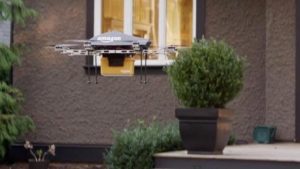
Amazon has revealed more details about their drone delivery program this month at the invitation-only MARS technology conference. Steven Levy of Backchannel was present at the event, and reports that Amazon is “definitely serious” about making drone delivery a significant part of their operations.
“I got some indications that the company is indeed gearing up for a massive effort to fill the skies with its vehicles,” says Levy. “It’s still very much in the test stage, but the progress Amazon has made jibes with the realization that drones are very much in our future.”
The newest demonstration of Amazon’s drone delivery technology introduces a new solution to the “last stage” problem – where and how the actual package lands. Currently, the team is delivering a box to a marker – a type of welcome mat or landing pad put out by the customer. The mat could be placed on the doorstep, but could also be placed in a more open area like the backyard.
The tests carried out at Amazon’s UK site have led to new developments. (Reportedly, Amazon is also testing in the US, at an “undisclosed semi-rural location.”) The sense and avoid technology has been improved upon, in order to avoid obstacles like clotheslines and pets (apparently Amazon uses a simulated dog to test this.) The endurance has been increased – Levy reports that Amazon now boasts a 20 mile round trip mission length, returning to a home base for a change of battery, with a payload of up to around 5 pounds.
While drone delivery seems to be a long time coming – the technology is still well out in front of the regulatory environment required, at least here in the US- Amazon is still leading the charge, indicating that implementation may happen sooner than we think. When it does, it may look something like this.

Miriam McNabb is the Editor-in-Chief of DRONELIFE and CEO of JobForDrones, a professional drone services marketplace, and a fascinated observer of the emerging drone industry and the regulatory environment for drones. Miriam has penned over 3,000 articles focused on the commercial drone space and is an international speaker and recognized figure in the industry. Miriam has a degree from the University of Chicago and over 20 years of experience in high tech sales and marketing for new technologies.
For drone industry consulting or writing, Email Miriam.
TWITTER:@spaldingbarker
Subscribe to DroneLife here.







The delivery drone will more likely lower the package via a tethered apparatus onto the “dronemat”, pilots will also compete in accurate drops on target gaining prestige in the delivery drone industry.